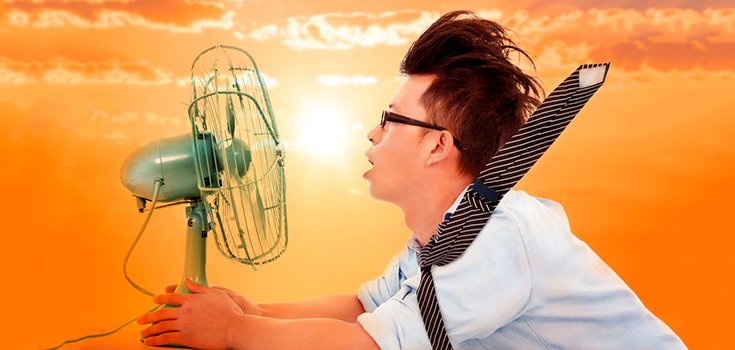5 No-Brainer Tips on How to Cool Yourself Down

With temperatures rising, it is important that you take the necessary steps to protect yourself, your family, and your pets from heat related issues like exhaustion and heat stroke. Here, I will outline 5 no-brainer tips on how to cool yourself down, as well as cover some important information about heat strokes and heat exhaustion.
According to the US Environmental Protection Agency, heat related deaths are the top cause of weather-related mortalities. This is especially true for those over the age of 65, for the economically-disadvantaged, and for those who suffer from cardiac and respiratory diseases. Thankfully, there are some very simple tips on how to cool yourself down and beat the heat to ensure that you and your family have a happy, healthy summer.
1. Air Conditioning

As you might have guessed, being in a place that has air conditioning, even for a few hours, can dramatically reduce your risk of developing heat stroke. If you have an air conditioning unit in your home, but are reticent to use it due to the cost, turn it on for a couple of hours and let your home cool. If not, go somewhere in your local community, such as a restaurant or library, that has air conditioning for an hour or so. Although fans might help take the edge off, they may not be enough to really cool you down as they simply blow hot air around. [1]
2. How to Cool Yourself Down – Drink Plenty of Water

Although it may seem like a no-brainer, it is important to get in an appropriate amount of water or fluids during hot days. While we’ll continue to hear different recommendations for water consumption, one you may want to follow is drink about half of body weight in ounces of water. You may not reach this, but aiming for it should lead to sufficient water consumption.
To ensure you’re drinking enough, purchase a one liter bottle of water at the grocery store and drink it throughout the day, holding yourself accountable to finishing it before the end of the day. Store it in your fridge to keep it cool.
3. Stay Out of the Sun When it is the Hottest

The National Health Service (NHS) in the United Kingdom recommends that you stay out of the sun during the hottest times of the day. They recommend staying indoors between the hours of 11am and 3pm, but depending on how hot it is outside, you may want to extend this until sunset. Try avoiding strenuous activity outside during these times, and do not walk your dog or take the children out to play during these hours.
4. Eat more Hydrating Foods!

Water is obviously a must-have in heat, but did you ever think about how eating certain foods could actually hydrate you? These hydrating foods are some of the best choices to have around while at the beach, pool, or just enjoying a day outside in your neighborhood (percentages may vary):
- Watermelon – 95% water
- Cucumbers – 97% water
- Celery – 95% water
- Radishes – 95% water
- Strawberries – 92% water
- Green peppers – 93% water
- Tomatoes – 94% water
- Coconut water
On the other side, you may want to stay away from foods and drinks like alcohol, coffee, salty foods, and sugary drinks, as these could lead to further dehydration.
5. Wear Loose Fitting, Light, Cotton Clothing

Wearing tight clothing can cause you to sweat even more and prevents sweat evaporation, making your body hotter than it would be otherwise. The same goes for wearing dark colored clothing, as it attracts the sun and doesn’t allow your skin to “breathe.” During hot weather, wear loose fitting, light colored clothing to help your body cool down and allow your sweat to evaporate.
Know the Signs of Heat Stroke

If for no other reason, you need to know how to cool yourself down in order to avoid heat strokes or heat exhaustion. Being aware and vigilant of the signs of heat stroke is especially important during hot days. The National Health Service warns that heat stroke can occur within minutes, or can come on gradually over a few hours or days of heat. Signs of heat stroke include: tiredness, feeling faint or fainting, headache, muscle cramps, a decrease in blood pressure, feeling nauseated, vomiting, intense thirst, and a fast pulse.
It is recommended that if you or someone close to you is suffering from heat stroke, that you have them lie down in a cool place and remove excess clothing. Use a cold wash cloth or ice pack to pat down their skin and offer them plenty of fluids. They should recover within 30 minutes or so. However, if the person does not begin to recover, or suffers a seizure or becomes unconscious, call an ambulance. Continue to pat down their skin with cool water until help arrives.
Heat Stroke in Animals

During extremely hot weather, heat stroke can also occur in your animals. If you have animals that are older or have heart conditions, it is important to keep them calm and cool. Ensure they have plenty of water. Every couple of hours, pat them down with an ice pack or tube sock with ice inside of it. You can also give them cold packs to lay down on.
Heat stroke in dogs can be very similar to heat stroke in people. Signs may include vomiting, diarrhea, panting, pale gums, bright red tongue, and weakness. If your dog is suffering from heat stroke, take him or her to the veterinarian immediately. In the meantime, cool him or her down with neutral water (water that is too cold may be counterproductive) and use a fan on his or her body to keep the dog cool.
Sources:
[1] Mayo Clinic
